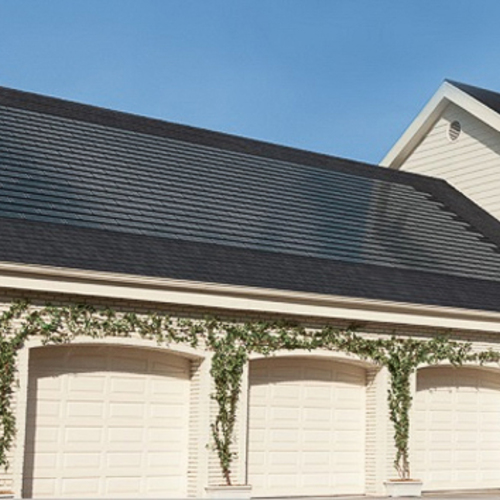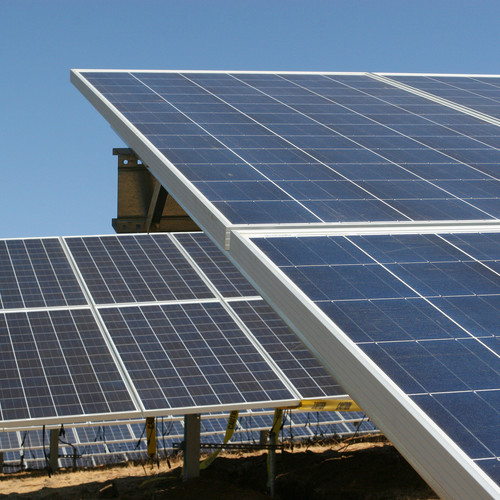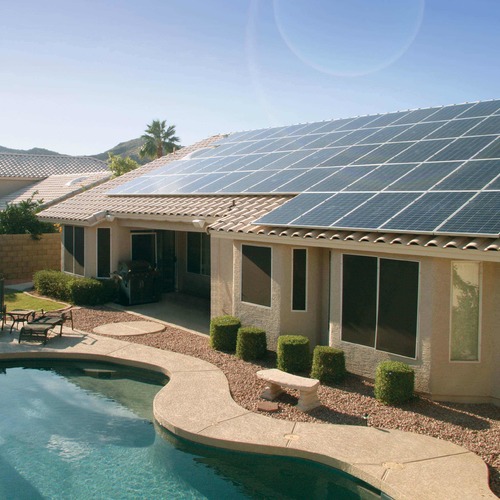
The U.S. Department of Energy has awarded $128 million in grants aimed at reducing the cost of utility-scale solar electricity from current levels of 4.6 cents per kilowatt hour to 3 cents per kWh in four years and 2 cents per kWh by 2030, moving the original timetable up by five years.
What Energy Secretary Jennifer Granholm called “this first burst of funding” is part of the Biden administration’s goal of a complete transition to clean energy by 2035.
Nearly a third of the money—$40 million—is earmarked for research into a family of crystalline materials called perovskites, which the department says can be used to make thin-film solar cells at a fraction of the cost of conventional silicon cells. Efficiencies have jumped from about 10% less than a decade ago to more than 25% under lab conditions today. When used on combination with silicon, perovskite cells have hit an efficiency of 29%, higher than silicon alone.
The money is going to 22 research projects, mostly of them at universities, the National Renewable Energy Laboratory, and a handful of private research firms. There’s another $14 million for a testing center that will validate the performance of perovskite solar cells—a project led by NREL and Sandia National Laboratories.
The department also said it was earmarking $3 million for a “Perovskite Startup Prize,” incentives intended to move production of these solar cells out of the lab and into commercial production.
Also part of the announcement were these programs:
- A consortium led by NREL will get $20 million to develop cheaper thin-film cells made with cadmium telluride (CdTe). This type of solar cell currently accounts for about 20% of total solar installations in the U.S. The department hopes the money will help lower manufacturing costs for CdTe cells and help U.S. makers get a bigger slice of the global solar market.
- $7 million for research that will extend the life of silicon-based PV cells from about 30 years to 50 years by improving components such as connectors, inverters, cables, and racks.
- $33 million for making concentrating solar-thermal power (CSP) plants more reliable and more efficient.
- $25 million to the Sandia National Laboratories to build a next generation CSP power plant and help reduce the cost of CSP-produced electricity to 5 cents per kWh by 2030.
Residential solar for $1 a watt
The announcement focused on cost reductions for utility-scale solar electricity, but the department also hopes that the cost of residential solar will drop dramatically over the next 10 years. Garrett Nilsen, deputy director of the Solar Energy Technologies Office, said the department hopes that costs can drop to 5 cents a kilowatt hour by 2030. He said installation costs should hit about $1 per watt. Currently, costs average $2.81 per watt after federal tax credits, according to the website Energy Sage.
Although silicon solar modules are likely to remain a powerful market force, perovskites could play a role in reducing costs to the consumer over time. Research on this set of materials started in earnest 5 or 10 years ago, Nilsen said, and their success to date, while impressive, is in a laboratory setting with samples measuring only a few square inches.
“Over that time we’ve seen massive improvements in terms of the efficiency and other performance metrics of the material itself, at the laboratory scale,” he said in a video call. “What we’re looking at now is how we can translate the laboratory-based promise into a commercial setting. How do we figure out how to manufacture these things, make sure they are stable and reliable, and can operate for 20 or 30 years and beyond as needed?”
Solar modules based on perovskites are not currently available, and they may be another 5 or 10 years in the making. Some of the recently announced grant money is going to companies that could help move the technology closer to commercial-scale manufacturing, Nilsen said, but there’s a lot of work remaining before consumers are likely to see these new modules.
The main allure of perovskite-based modules is lower cost. The material is cheaper and less energy-intensive to manufacture than silicon wafers, and it may lend itself to more automated manufacturing, such as printing or depositing thin films directly on glass, which also would help lower costs.
“When we continue to look at increasing the performance or making new manufacturing processes to drive down costs, we’re increasing the lifetime of photovoltaic materials as a whole,” he said. “It’s all about cost reductions. Some people will go solar for climate or other reasons but mostly it’s going to be for financial reasons.”
Asked whether this new family of materials ultimately could displace silicon as the raw material in residential solar modules, Nilsen added, “It’s always hard to bet against an incumbent. If you go back 5 or 10 years, there were other material sets that had some really great performance in the lab but ultimately, when it came to manufacturing, they weren’t able to carry that over. In parallel, silicon costs have continued to go down to levels that were not expected 10 years ago. And with that came increased performance.”
While Nilsen’s office is devoted to early-stage research and development, he said the DOE also is working on two other issues that can slow a wider adoption of photovoltaics: the non-hardware or “soft” costs of solar energy—which now make up about two-thirds of the total cost to consumers—and interconnection issues that can complicate the integration of renewable energy onto the existing utility grid.
Scott Gibson is a contributing writer at Green Building Advisor and Fine Homebuilding magazine.
Weekly Newsletter
Get building science and energy efficiency advice, plus special offers, in your inbox.















4 Comments
Thanks for the article.
(Edit: spelling error fixed in article)
> utility-scale solar electricity from current levels of 4.6 cents per kilowatt ... 2 cents per kWh by 2030
I'm curious how this is consistent with (from other sources) "Saudi Arabia’s second PV tender draws world record low bid of $0.0104/kWh" or "Nationwide average levelized power purchase agreement (PPA) prices fell to $24/MWh in 2019".
Whatever the right numbers, it should make sense to design for clean/cheap sunny (and windy) period electricity.
“[Deleted]”
“[Deleted]”
Log in or create an account to post a comment.
Sign up Log in